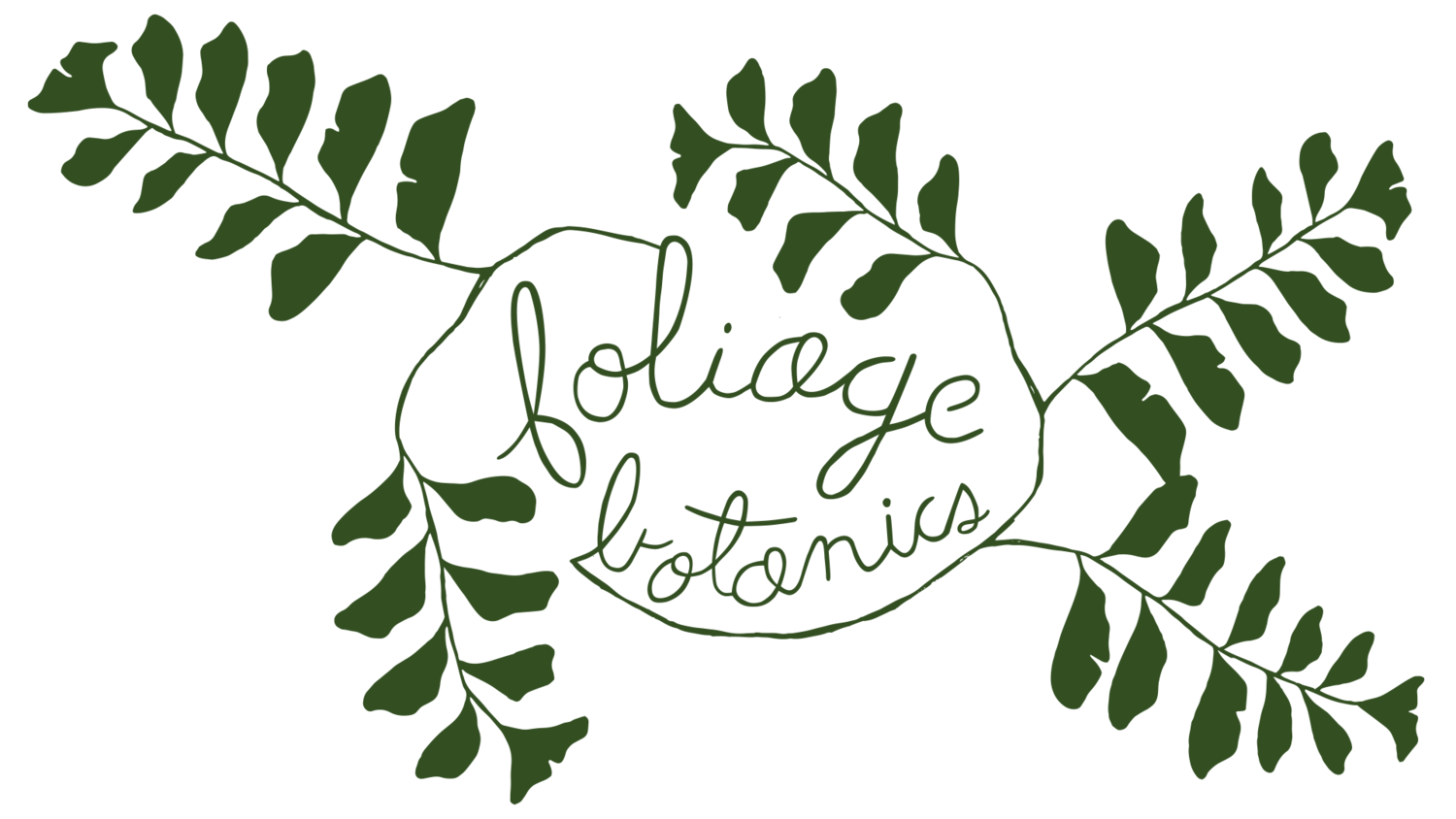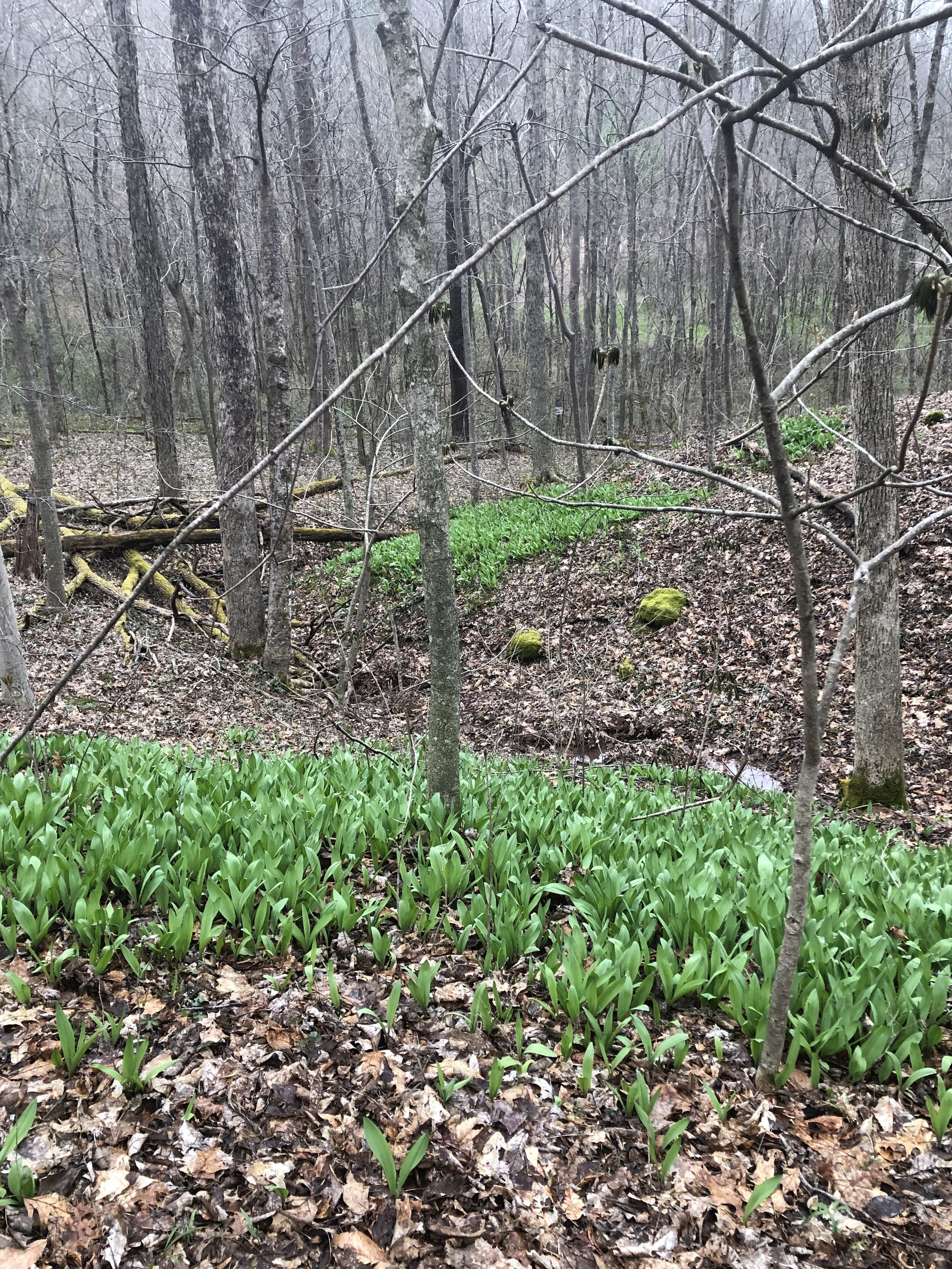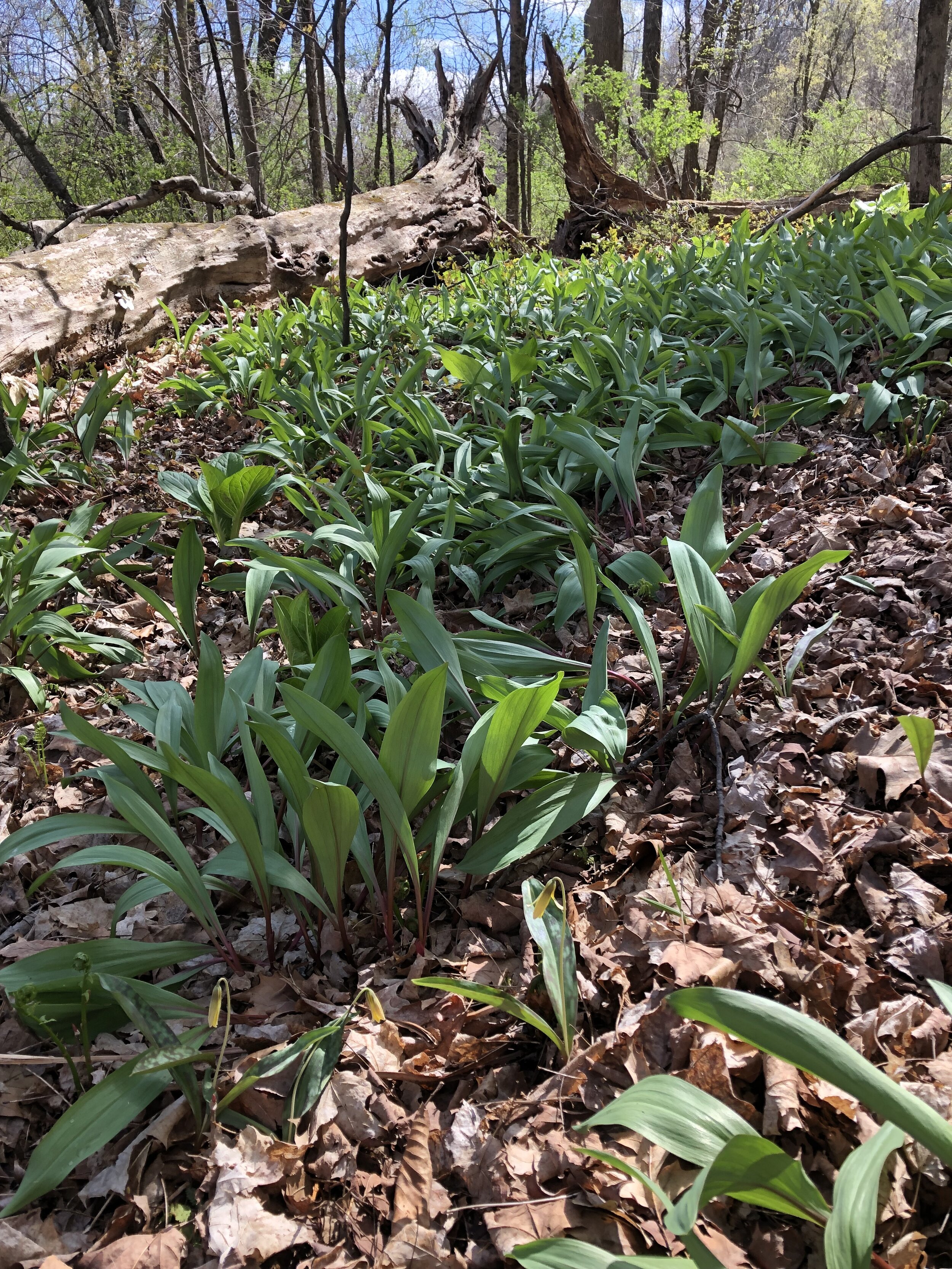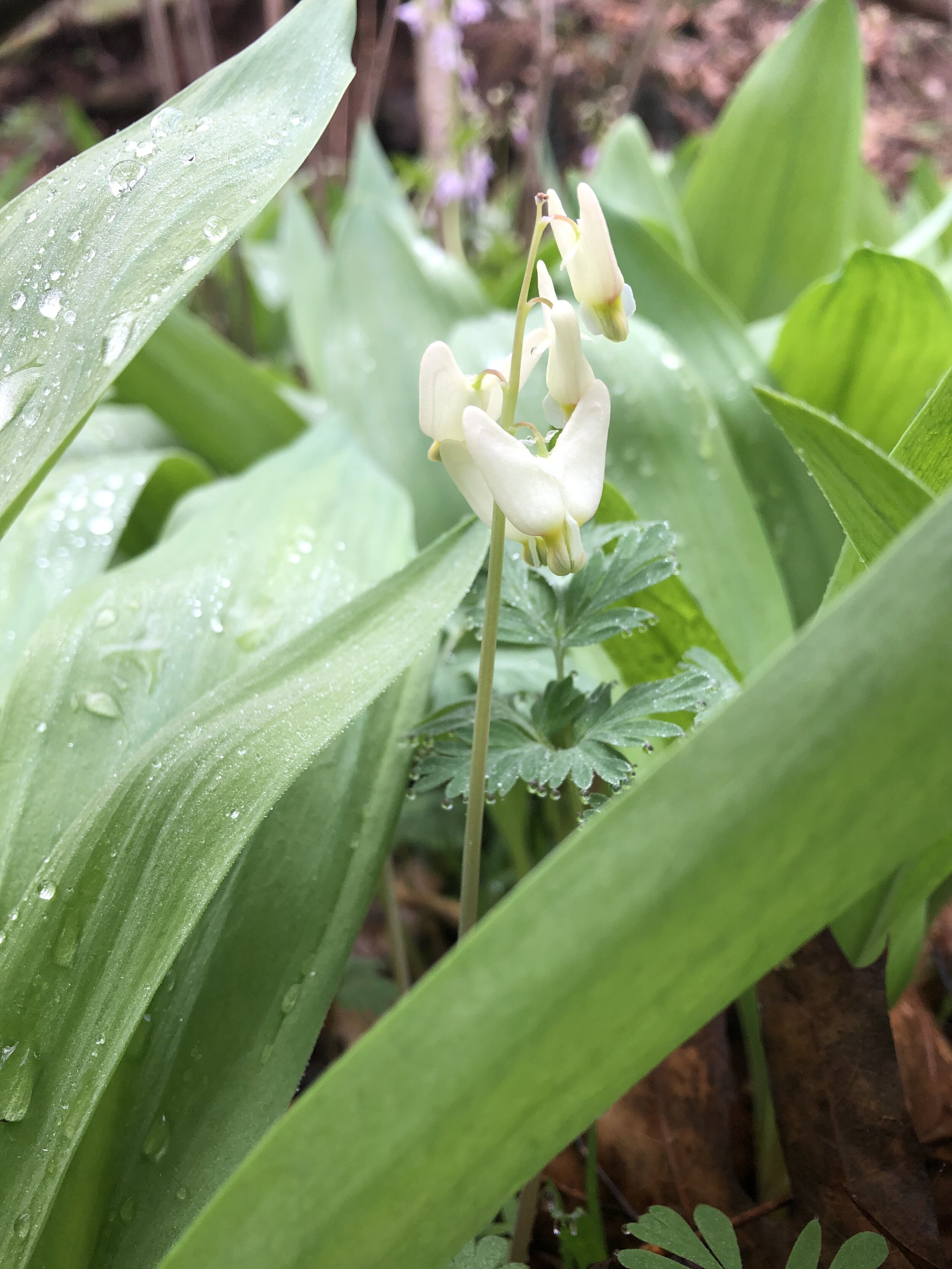The Fight for Ramps!
At a bend along the creek here that I like to visit often throughout the year—past the huge fallen oak rotting on the hillside leading down to the water, so big I can crawl inside it and take shelter from the rain, and farther still, just beyond the strange patch of scouring rush all wiry green and bright throughout the winter months—there’s a huge patch of the notable wild edible Ramps. Right now, as I write this, small perfect purple shoots are piercing the leaf duff, two tender green leaves are splitting through their sheath, unfolding, shaking off the morning rain and broadening in the sunlight pouring in through the open, leafless tree canopy.
Ramps emerging in the rain.
This is a plant I feel extraordinarily passionate about. A native wildflower and woodland understory plant that often grows in the floodplain of a woodland ravine, ramps (or wild leeks as some call it, referring to edibility and taste, like a sharp strong mix between onions and garlic) grow amidst other special treasures—trilliums and bloodroot, dutchman’s breeches and ostrich ferns—a sweet and magical community of rare ephemeral blooms that have faced years and years of ecosystem degradation and population demise.
Ramps specifically have now long been an overly-popularized wild edible spring green, delicious, vibrant and choice, dug up for their onion-like bulbs and touted by restauranteurs proclaiming their terroir and local and wild offerings. And this has had detrimental consequences.
Plants like ramps, native understory herbs, are slow-growing. Ramps themselves take about 7-10 years to reach full maturity to set seed and reproduce and a ramps stand, if heavily harvested, takes more than 20 years to bounce back to full vibrancy, if it even does at all. And ramps role in the forest is far more intricate than is often discussed, a fine balancing act of nutrients and minerals and soil building. Ramps are said to play a huge role in nitrogen mineralization in the environment, storing vast quantities of nitrogen and other minerals in the early spring, nitrogen “sinks” as they are called, and then slowly releasing them for use over the rest of the season for other plants to use as they become more active, thus playing a huge role in nutrient stability in the forest. For all of these reasons, I spend every spring doing my best to advocate for these small special plants. A huge part of my goal and life’s work as an herbalist and plant person is to promote this one simple idea: not everything’s role and purpose and benefit is for us. Despite how delicious and cleansing ramps are, using them is not worth the expense of an intact native plant community like the one I’ve described. It is my firm opinion that we need to leave ramps be. As one of favourite wild foodies, Mallory O’Donnell, expressed: “if I can live without them, so can you.”
Ramps piercing through the leaf duff. This is one I found that got twisted up in the leaves and I thought it was so beautiful.
Ecologically, balance is everything. As humans we tend to have this very self-centered attitude about conservation and about the environment, that it needs our intervention, our cleaning up, our control, our management to thrive. The truth is, the forest is better off without us messing around in there, and, in fact, we most often do harm when we try to “help.” With harvesting, it is really no different. When we harvest large swaths of these patches—and they really grow very thickly in wide stands when healthy and mature—we open up empty space in the forest floor. Because these and most native plants are so slow growing, that space is quickly usurped by opportunistic, aggressive, fast-growing, and often problematic plants, thus decreasing the odds the natives will return. Those plants I speak of are here too by our own—we, the people—by our mistake and misguidance and we continue to flub it all up still, carrying their seeds unknowingly into the woods on the bottoms of our shoes or attached to our wool sweaters, digging up the forest floor, taking trees down and letting in more heat and light. Minor things that make a big difference in the plant world where time moves at a different pace.
More specifically, with ramps, I really say the best harvesting advice to promote is “please don't!” In other words, to not harvest these plants at all, even if you feel like an ethical, gentle harvester—if you’re harvesting from a patch, even on your own property, you never know who else might be coming there and taking some as well, and collectively, you could be putting significant pressure on the population. If you are certain, beyond absolute certain you’re the only one, these are the ethical principles I outline and ask everyone to follow:
harvest leaves only, one leaf per plant, one plant per 25 or even 50
take only for yourself and only what you can use
never buy ramps and never sell ramps—even if you know they are sustainably collected, it only promotes this intense over-obsession with the plant. I, personally have seen people popping out of the woods with garbage bags full of ramps, roots and all, to sell at the market or to restaurants, and it’s simply heart-breaking. As long as people know they are desired and can get paid a high price for ramps, they will heavily harvest them and sell them. We cannot promote this in any way with our social platforms, our actions, or our dollars.
wild tend your ramps patch! You can plant ramps! You can go back in the fall after they have flowered and spread their little dark seeds around! You can take a few years off picking the leaves and let them replenish and regenerate! You can sit amongst them throughout the season, watch them grow, read them poetry!
This year, we have the unique and strange experience of restaurants being shuttered, events cancelled, festivals closed down, and markets minimal. I think it’s a rare and perfect opportunity to do a little shifting as a society about how we look at plants and particularly these ones we have spent a lot of recent years abusing. An opportunity to find a little balance, to shift our mindset about the forest to one of stewardship, to learn to sit and be and admire from afar. At least, that’s what I’m going to do.
Ramps flowers exploding across the forest floor in late July. Later you can go back and collect the little round black seeds to spread elsewhere or just replant into the soil to assist their self-propagation.
Me in the ramps patch on the land where I live.
Some links to other articles:
https://unitedplantsavers.org/ramps-allium-tricoccum/
https://www.grit.com/food/ramps-wild-leeks#axzz2yCpIbusb
https://plants.usda.gov/core/profile?symbol=ALTR3
https://www.nytimes.com/2011/04/20/dining/20forage.html
https://unitedplantsavers.org/wp-content/uploads/2020/02/Plugging-the-Leak-on-Wild-Leeks_Edgar-Brubaker-Tuminelli.pdf









